In the summer of 2012, Mr. Oddbooks and I drove out to Baby Head, Texas. A real place. I swear.
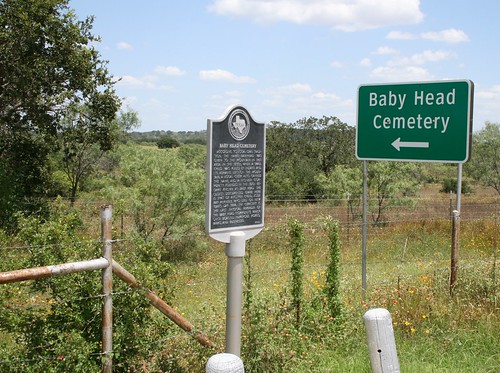
It’s a ghost town now, more or less incorporated into Llano, Texas, and Llano was a weird place in its own right. We drove around forever trying to find the remaining Baby Head post office and never found it. But we did find plenty of Apostolic churches, Cowboy Congregations, exotic animals being raised so weekend warriors can obliterate them with assault weapons on canned hunts, and several hidden little cemeteries that I really want to go back and investigate, as long as I can remember to wear steel-toed boots to repel all the grass burrs and fire ants.
Back to Baby Head. The town got its name because “oral tradition” says that some time between 1850-1875, a local Indian tribe kidnapped a white child, killed it, and left it on a mountain that came to be called Babyhead Mountain. (The town’s name and the cemetery’s name are Baby Head, while the mountain is Babyhead. Don’t ask me why. But even that isn’t carved in stone as you will find the town, the cemetery and the mountain all referred to as “Babyhead” or “Baby Head” with no real explanation for the variations.)
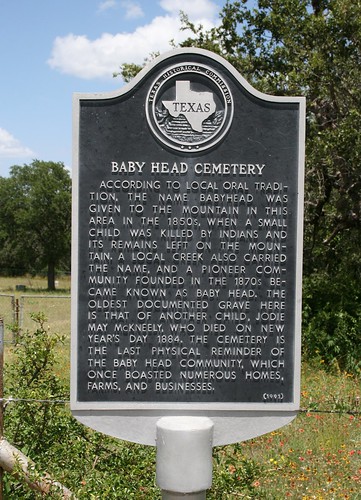
It’s hard to know if there is any truth to this legend. The tribe of the Indians who supposedly killed the baby is unknown, though if hard-pressed I would say it had to be Comanches, a pretty harsh tribe to be sure. The name of the baby is also officially unknown, but it is assumed to have been a little girl. I personally suspect the baby’s designated gender is because the oldest grave in the Baby Head Cemetery belongs to a little girl who died on New Year’s Day in 1884, though one local historian insisted her late husband knew people who searched for the child. The woman’s husband said the little girl was murdered in 1873, and that her name was Mary Elizabeth Buster. I have never been able to run to ground a Mary Elizabeth or a Mary Elizabeth Buster from Baby Head in 1873, but I also have a notoriously short attention span. This article by Dale Fry best illustrates all the stories about this Texas legend.
I had read several accounts of how creepy Baby Head Cemetery is. It wasn’t creepy. It was interesting, and sort of macabre in a very sunny way, but mostly it was painful.
I have never encountered more grass burrs per square foot than I did in Baby Head Cemetery. It was July, 105 degrees Fahrenheit (40 degrees Celsius, for my readers abroad), but we were prepared for the potential problems one encounters in Texas. We both had on long sleeves, jeans and reasonably proper footwear and within two minutes inside the gate, from the calf down we were covered in burrs that picked through our shoes and socks. Seriously, next time we both need to be in heavy boots. A couple of people showed up while we were there, tourists attracted by the road sign, and they lasted less than a minute. One woman in flip flops and shorts actually screamed in pain.
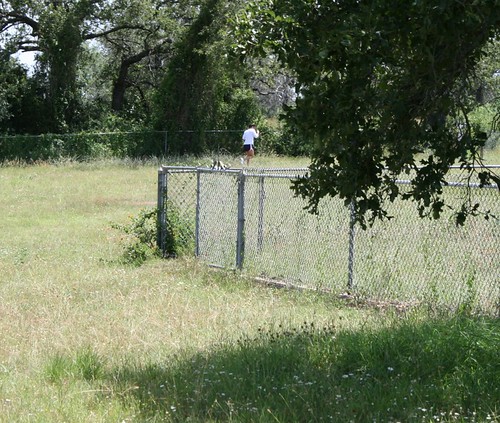
It’s hard to see that she was running out of the cemetery, but she was. And she was straight-up screaming as she did it.
We later saw some men leaving a different cemetery a bit south of Baby Head and when they left they removed their pants, standing in their underwear by their cars, struggling to remove the burrs. I didn’t take pictures because they were at the cemetery to pay respect to a friend or family member and who needs a city slicker taking pics of you in your tighty whities when visiting grandma left you covered in painful burrs. Still, I mention them because the pain was so intense they couldn’t endure staying in their pants long enough even to wait through the usual burr-removal-process (it involves a stick and lots of complaining).
Those burrs made sure I raced through the cemetery. I did, however, manage to get some interesting pictures of this weird, weed-ridden place. I became interested in cemetery investigation because I really enjoy decoding the funerary symbols on gravestones. Most modern Protestant stones tend to be pretty unremarkable but in older cemeteries, especially Catholic ones, you can find all sorts of interesting symbols and statuary. I also like periodically looking up the names of the people I find in unusual cemeteries or whose stones and plots seem particularly interesting. A few of the stones in Baby Head Cemetery had interesting iconography.
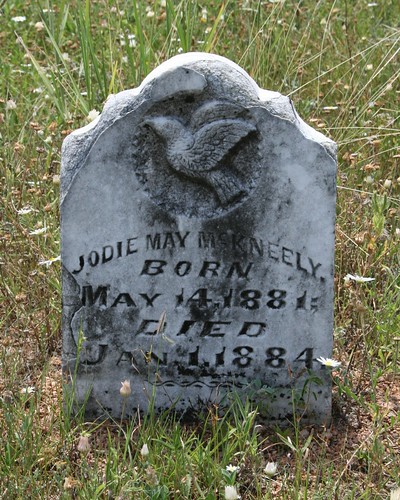
This is the oldest stone in the cemetery, the grave of the little girl whose death I personally suspect has colored the legend of the child murdered by Indians. When the first person buried in a frontier town cemetery happens to be a female toddler, it can cause people to engage in macabre stories. The dove on Jodie May McKneely’s stone indicates Christian purity and God’s promise of safety after the flood, and is a common image on the graves of children or unmarried young woman. This stone appears to be sinking, which is sort of odd given that most stones this old and in such a hot, dry place tend to break. I suspect this stone broke and that the top of the stone was reburied. For people who live in Europe or in New England, a stone from 1884 doesn’t seem that old but in Texas, this is some ancient history right here.
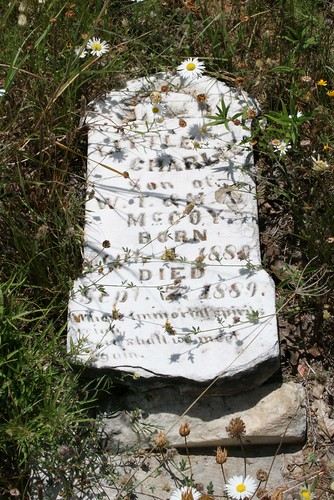
This grave of Charles McCoy, who died as a baby, is just one of many gravestones belonging to little children. Old cemeteries in Texas are a stark reminder of how often families lost babies and little ones. The extraordinary number of dead children and babies stems off around 1950 in most of the cemeteries I’ve visited. The top of this broken stone has a lamb, a common symbol used on the graves of babies and young children to indicate a meek, mild purity. The bottom of his stone says, “Where immortal spirits reign, we shall meet again.”
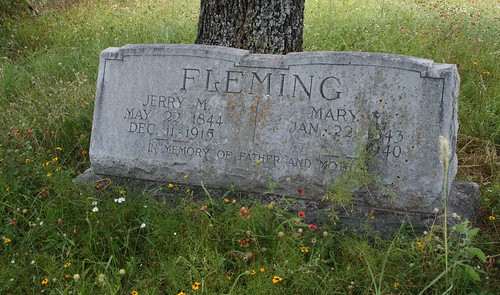
This stone caught my eye because of the birthdate of the couple, and because my father was named Jerry and my mother is named Mary. You look at this picture and it seems so peaceful and nice. Shady tree, pretty flowers. Except that it was boiling in the shade and all those pretty flowers were producing miserable burrs. Also it was right next to a portojohn. You don’t want to be close to a portojohn in Texas in the middle of summer.
I really liked Martha’s stone because it is the sort that demanded a little bit of attention in order to understand it. Clasped hands are often a symbol of marriage, with the cuffs and hand size to indicate a man’s hand and a woman’s hand, symbolizing that a married couple would meet again in Heaven. If the cuffs are the same, then the image is indicating a farewell from this mortal coil. The stone is too faded for me to see if these hands were supposed to indicate a man and a woman but I do know Martha died just after her fifteenth birthday. Even in the old West, it’s unlikely she would have been married at such a young age. The hands likely mean to indicate an earthly farewell. And since the word “farewell” is over the hands, this seals the deal for me.
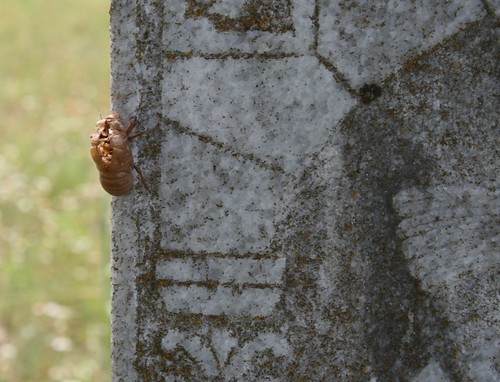
Thankfully, given the heat, the ants, the burrs and the smell, we missed the plague of locusts.
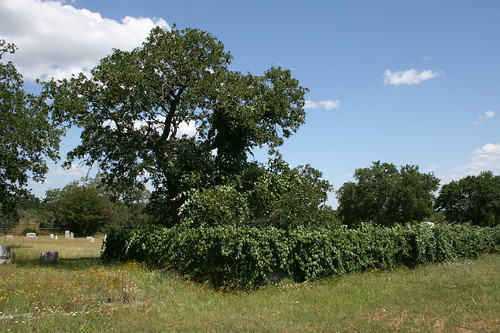
There was a fenced off area in the cemetery devoted to the graves of one specific family and because I lack common sense and was already quite miserable, I decided to enter this area.

The little fenced off area was overgrown and the burrs ensured I didn’t try to battle my way to get a closer look at the stones. But I do have to admit it was pretty peaceful in this section of the cemetery.
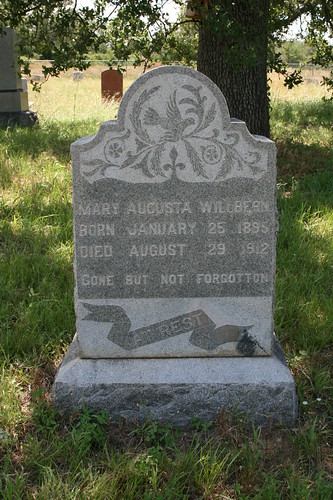
I invariably have a favorite stone from every cemetery visit, and Mary Augusta Willbern was my favorite at Baby Head. I like the appearance of her stone – it seems cheerful, if a gravestone in a Protestant cemetery can ever seem cheerful. I also love this stone because the images used to adorn it require more interpretation than the average stone. Mary was only 17 when she died, so the image of the dove makes perfect sense, as it is a symbol of purity and God’s promise of peace. The dove is carrying a palm frond, a symbol of resurrection, and what I believe is an olive branch, another symbol of God’s promise to man after the flood. However, it is interesting to note that the dove is carrying both branches with her feet and that they are not held in her beak. An olive branch in a dove’s beak is often a Catholic symbol to indicate the Holy Ghost. This dove is holding the olive branch with her feet, which makes sense since this is a decidedly Protestant cemetery.
As I mentioned earlier, the entire Llano area was pretty interesting and sort of horrible. I would very much like to return because every tiny road you drove down featured something for the curious explorer.
We saw several tiny frontier cemeteries tucked away off tinier country roads but could not endure the thought of dealing with more burrs. You had no idea what you would encounter beyond the bend because several of the roads featured free-roaming livestock. Like longhorn cattle and Brahman bulls just wandering in the road, sometimes settling down on the gravel for naps. And then there were the canned hunt animals…
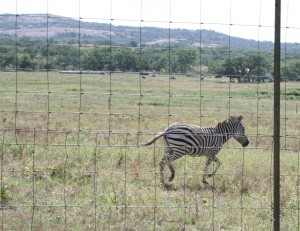
Yeah, this zebra is probably dead now, killed by a scumbag who totally just had to pay money to shoot a pretty animal that is not native to this area. I’m not anti-gun or even anti-hunting but if you’re such a jaded piece of shit that you just have to kill an animal that someone imported for the purpose and kept in a field wherein the animal had no chance of escaping, you need to reevaluate your life and choices because you are a complete asshole.
Hopefully we’ll go back soon and check out some of those other cemeteries we encountered as we drove around. And I really hope all those zebras managed to cause some damage before some unethical, cowardly dumbass shot them to death, but that seems unlikely since they were not nearly as skittish around humans as they needed to be.
As often happens in Texas, that which is meant to be creepy turns out to be weird. I think there is a lot more curious weirdness hidden down those little gravel country roads that will prove to be every bit as interesting as Baby Head, Texas.
**I photographed over 100 gravestones during this trip but evidently never edited them or made them public when I uploaded them. I will be editing them soon so bookmark my Flickr album with these Baby Head pics if you want to see more in the future.**
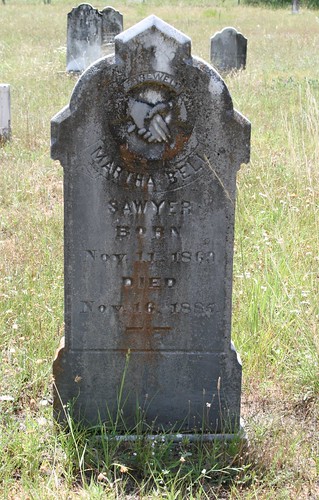

baby head, so very texas. I am intrigued.
when we first moved here a friend said not to go out in the yard without shoes because of “the burrs” so I threw on my flip flops and headed out, naively. several moments later I was pretty sure I had stepped into hell, and had to limp from foot to foot all the way BACK through the nightmare. God damn those things!
As a native Texan who has spent some time out in the wilds of west Texas, I was wholly unprepared for the burrs we encountered out in Baby Head. This was near Biblical in scope. GAH!
I’m wondering about the Maria Cantu headstone photograph on your Flickr page (I didn’t see an obvious way of commenting there). Was the photo, on the stone, added later? It appears cleaner than the rest of the stone and I would have assumed that putting a photo on a grave marker is a process that was developed in more recent times – later than 1933.
David, sorry about that. Flickr is a complete nightmare for me these days, too.
The photo-transfer techniques that permitted Maria’s stone to have her picture were around in the 1930s. It’s been a while since I’ve read about the exact techniques but my money is a porcelain or ceramic transfer. Her stone is almost completely covered in live brush. I had to more or less climb into the brushy area and ask my husband to hold one of the branches back. It appears to me that she’s likely been in the shade for a long while, which cuts down on some of the fading you can see with other porcelain or ceramic transfers. Lots of similar stones from similar time frames are pretty faded from decades of sun exposure – I think being in the shade helped Maria’s photo stay so crisp in appearance.
Maria Cantu is one of my favorite stones from Santa Maria cemetery.
And just to share the pic David is referring to:
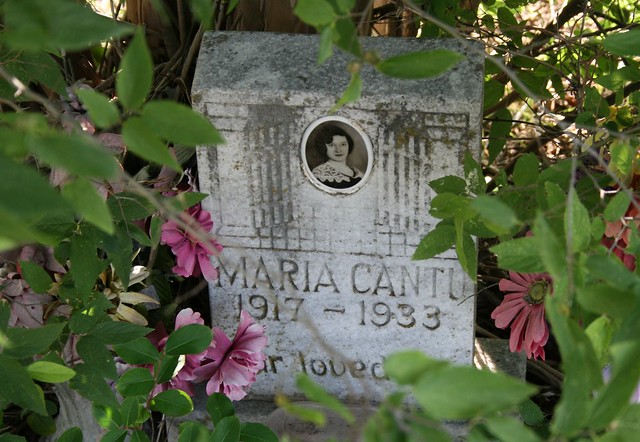
you must be talking about goatheads, not ‘burrs’
i liked the story about Baby Head Cemetery till you ruined it by cussing at the end about hunting zebras.
Hoo boy, you best stop reading here entirely, Randy. If my use of “asshole” to describe the sorts of scumbags who pay to kill semi-domesticated exotic animals is enough of an issue to cause you to comment about it, you definitely do not want to read my review of Tao Lin or my opinions about mass murderer Anders Behring Breivik. Glad you enjoyed the article up to that point though!
My wife and I just returned from a visit to Baby H Cemetery. It was hot but not over 95 f, cloudy and breezy, which made for a nice day. We didn’t run into any ants or burrs, and my wife wore flip flops and shorts. I’m curious about the coins left on gravestones. I’m familiar with military tradition of leaving coin to show respect, but wasn’t aware of the practice for civilians. Is this to demonstrate respect as well? Also I really enjoyed your piece, and completely agree with you regarding cowardly asshole chickenshits on their canned hunts. I think it should be legal to hunt THEM in the hope their genes can eventually be eradicated from the pool. Rock on,
I am unsure why people are leaving coins on graves myself. In the past, as you noted, it’s something that was done to honor military personnel but I think the notion of respect is bleeding over into other graves.
When I visited the “Liberty Hill Witch Grave” I noted coins all over the cemetery. The coins left for “Elizebeth” harked back to Caribbean beliefs that offering coins or gifts to people with supposed mystical powers could persuade them to perform some sort of miracle for you or buy your freedom from any sort of ill-intent aimed at you. Since the legend is that “Elizebeth” was a witch, lots of little items, from coins to toys to cigarettes were left as gifts for her, to curry favor or avoid her vengeance from beyond the grave.
But because her stone has been wrecked, gifts, especially coins, are being left on other graves in the cemetery, mostly childrens’ graves or the graves of people who were born or died near Halloween. Lots of these rituals seem to make sense in the local milieu in which they happen but don’t seem linked to old customs of coins to show military respect or ancient customs of placing coins over the eyes of the dead so they could pay the ferryman to cross the river Styx and similar rituals. With instant access to the Internet and catalogues of belief, a teenager who just wants to show respect to an alleged witch in a unique way can cobble together ideas, execute them and before long people who come behind him mimic the actions.
I still wish I could find out why people leave shells on cemetery plots, especially Mexican-Catholic graves and gravestones. It’s something that happens in border and Gulf of Mexico coastal towns in Mexico and has made its way to Texas cemeteries but even venerable historians are unable to express it.
Thanks for the comments about canned hunts. May the shame of killing just to kill and killing the unique just to kill the unique haunt all canned hunters like a dead witch in Liberty Hill.
Sir, I found your article quite vacuous and shallow as well as sarcastically mean. You clearly dislike Texas without taking the time, perhaps, to understand the culture which you so easily (and, IMO, incorrectly) paint in a decidedly ugly fashion.
As far as Zebra hunting goes, MANY Texans agree with you. However, I feel that this does not excuse your rude comments
I invite you to contact and meet with me at Baby Head if you wish to revisit this story. I’ll even treat you to some BBQ.
Very politely yours,
Dr. John Paladin
Sir? I prefer to be referred to as Lady Vacuous Shallow-Sarcastic, nee Mean, lifelong Texan, and getting older by the day (aren’t we all?). You may kiss my hand if we ever meet, but until then if you disagree with any of my historical discussion of Baby Head Cemetery, let me know. History is often altered a bit when old facts are looked at in new ways. And there will always be people who know more about history than me.
I beg you forgive my provincial nature. My people came to Texas because they were sick to death of the mentality that still permits elites – be their power from imperialism, dynasty or recently acquired wealth – to shoot and kill whatever they want as long as they can pay for it. I know most Texans agree with me, and not just because my parents – both native Texans – never paid to have access to a ranch where wild animals were imported, raised and deprived of instinct so that they could be more easily shot and killed. Rather, I know this because (and look away now lest you encounter another rude word at the end of this sentence) most human beings are not pieces of shit.
Really, I can speak far cruder and far meaner on this topic. I know Freud has been largely discredited but it’s hard not to invoke his ideas when considering the mentality of a man who pays to kill an elephant (or rhino or zebra or giraffe or whatever else is majestic and evidently worth killing) with a very large gun that someone else probably has to carry for him. It’s almost as if such men are trying to overcompensate for something. If only public decency permitted me to speculate on the specifics.
Yes, let’s have a zebra-roast and liquor hootenanny among the dead. Surely that will not be an affront to god and man. I’ll be the short woman in reading glasses humming “Have Gun, Will Travel” and I assume you’ll be the one wearing a suit made of dead lion cubs?
Obliterated by weekend warriors with assault weapons my ass and if you don’t like The way we do things here then The way we do things here then get the fuck out your dumb cunt.
Hit the reply button once, Jeff. Your trigger finger is twitchy, I fear.
Obliterated by weekend warriors with assault weapons my ass and if you dont like the way we do things here in Texas then get the fuck out you dumb cunt.
Hey, Jeff, my ancestors and I have been here for a long damn time. I’m descended from people who hunted Texas animals in order to eat, to survive, and they took no joy in killing. It was just something that had to be done – it was a chore meant to obtain food, like weeding the garden or canning beans. You are in the minority on this issue, Jeff. The vast majority of Texans frown heavily on the import of exotic animals so shitheads with identity issues can feel like they are on safari, killing for the bloodlust that comes from destroying something for the sheer perversity of it.
This is not how things are done here in Texas. It never has been. It’s always been the purview of bored men and psychopaths. So maybe you don’t need to appoint yourself arbiter of what is done here in Texas and what isn’t, and if you’re gonna front this way, maybe just stick to name-calling since I suspect my kin and I have been here way longer than you have. But this isn’t a pissing contest about who’s lived where longest because human decency has no single address – stop killing imported animals that you have no intention of eating, wearing or otherwise utilizing, you miserable little man.